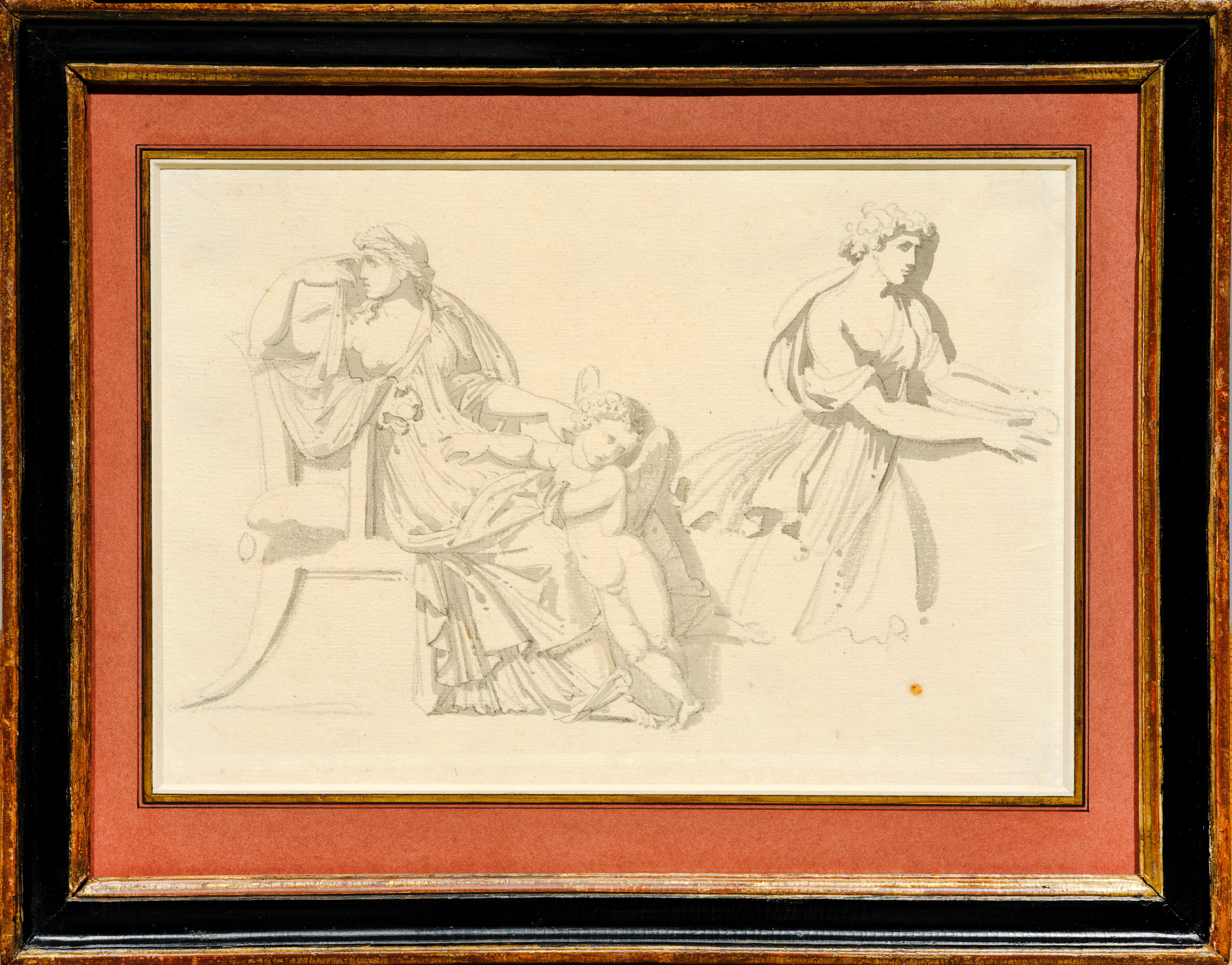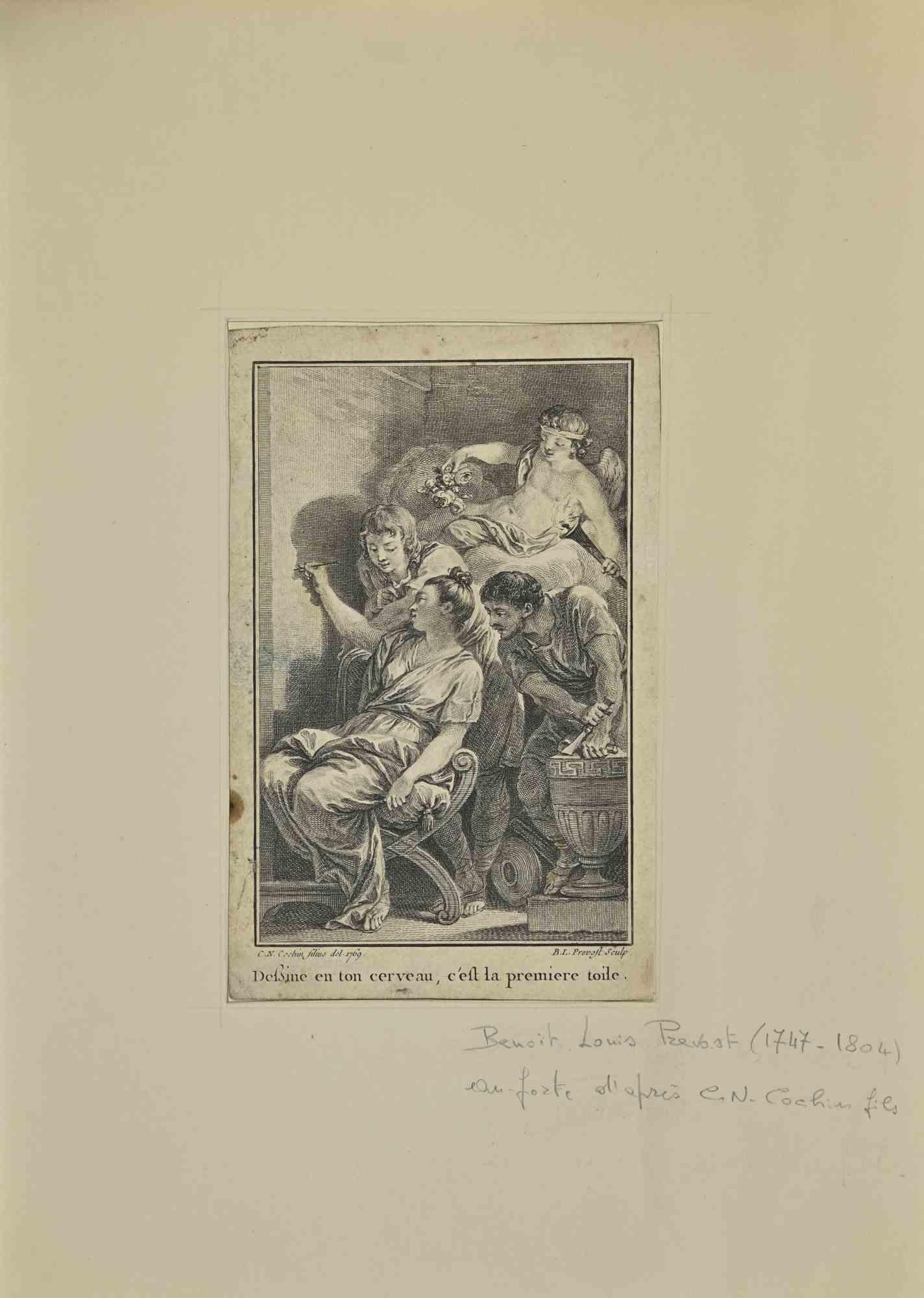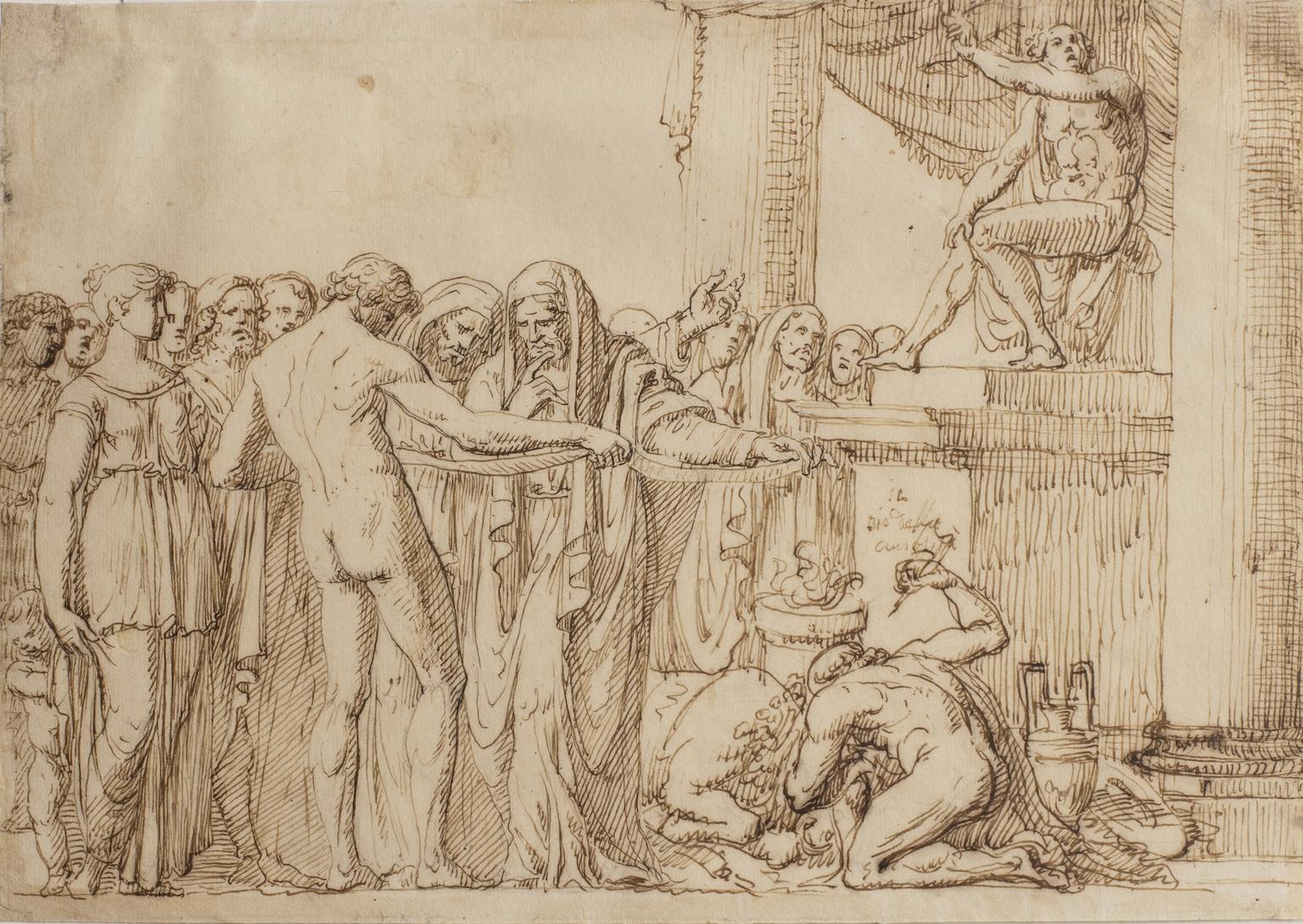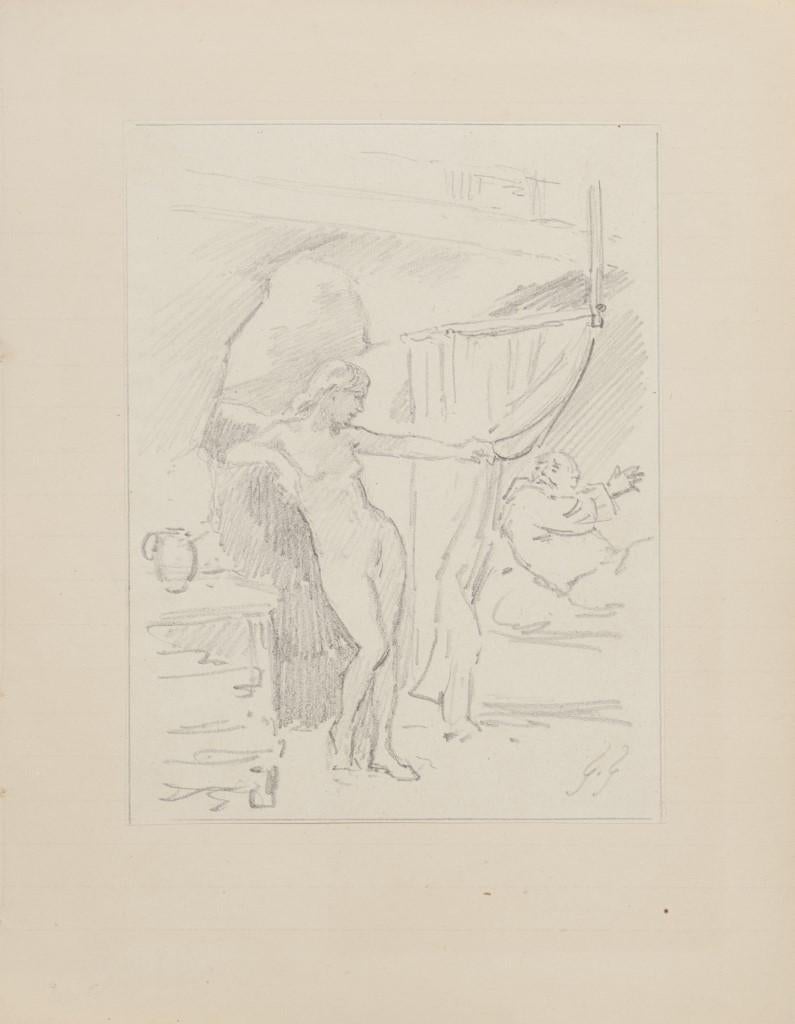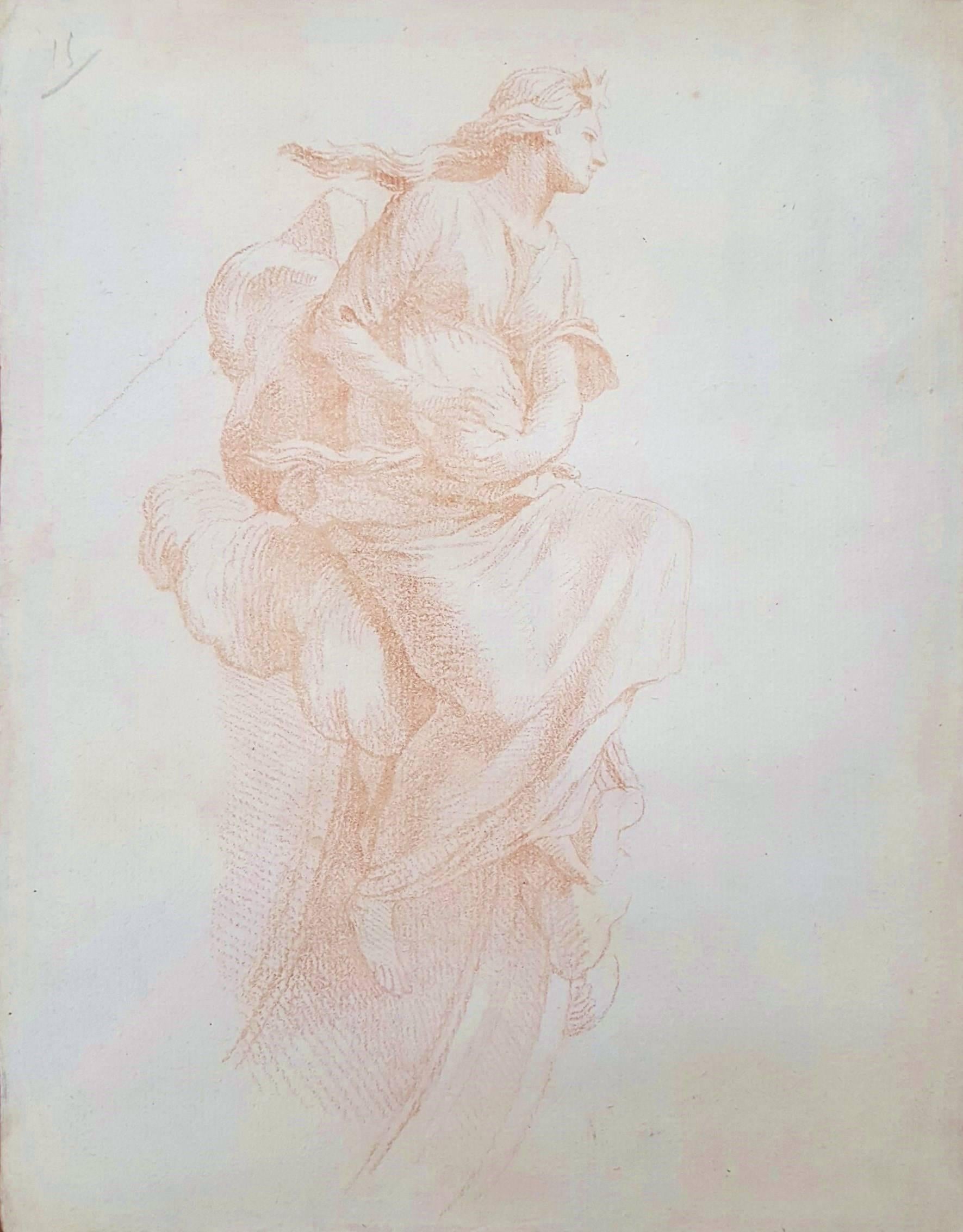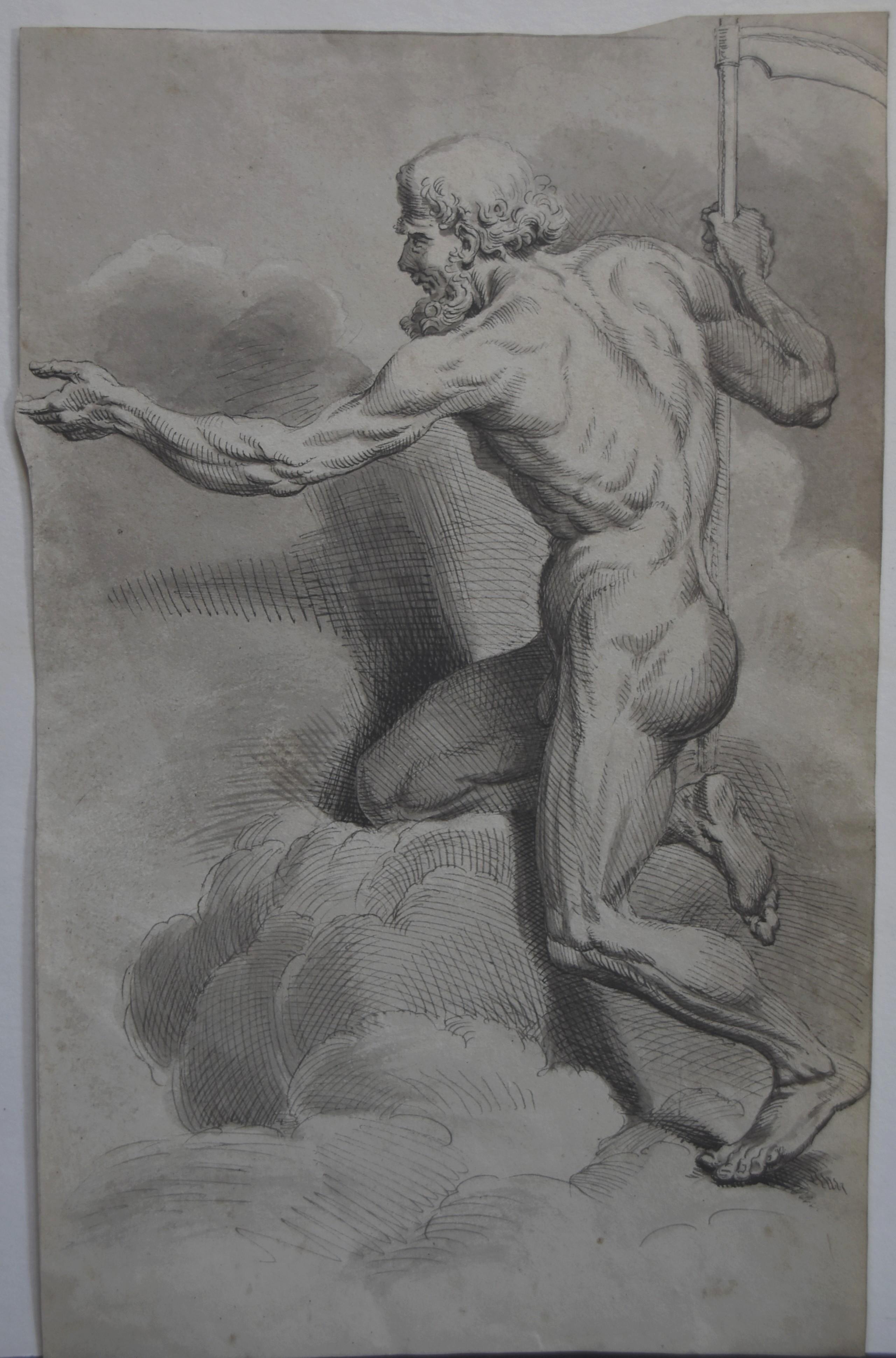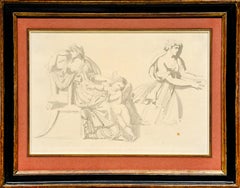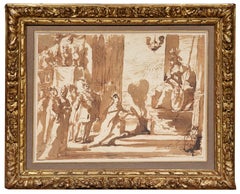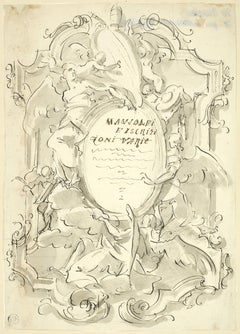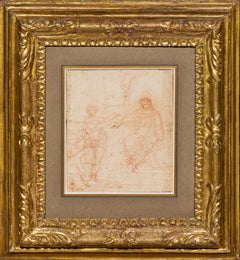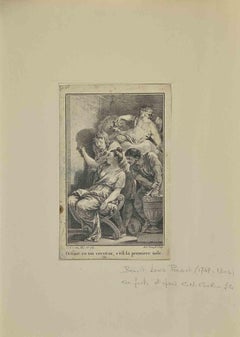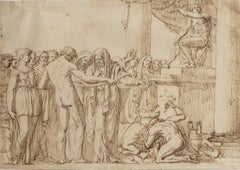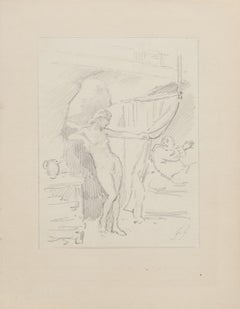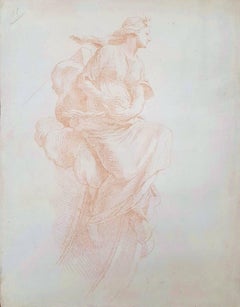Items Similar to Study in the Antique Style, a neoclassical drawing by Augustin Pajou
Want more images or videos?
Request additional images or videos from the seller
1 of 7
Augustin PajouStudy in the Antique Style, a neoclassical drawing by Augustin PajouCirca 1752
Circa 1752
$5,606.68
£4,145.09
€4,700
CA$7,711.91
A$8,572.27
CHF 4,493.40
MX$104,688.10
NOK 56,097.48
SEK 52,777.26
DKK 35,781.02
About the Item
In this lively and fresh drawing, probably taken from one of the artist's notebooks, Pajou presents us with a composition freely inspired by antiquity, as a souvenir of a visit to the Villa Borghese. This evocation of the artist's Roman sojourn is made even more moving by a self-portrait sketch of the artist on the back of the sheet...
1. Augustin Pajou in Rome, a great sculptor in training
The son of a journeyman woodcarver, Augustin Pajou entered the Royal Academy school at an early age, where he trained under Jean-Baptiste II Lemoyne (1704-1778). Laureat of the grand sculpture prize in 1748 (at the age of eighteen), he joined the Royal School for protected pupils, received an annuity from the King from 1751 onwards, and stayed at the Royal Academy in Rome from 1752 to 1756. These years in Rome were to have a decisive influence as they allowed him to study not only his art but also to receive a classical education which he had not had access to in his youth.
Back in Paris, he received his license from the Royal Academy in 1759 and was finally accepted the following year. An extremely prolific and diverse artist, he was a sculptor, a decorator and a "bustier" creating terracotta or marble effigies of the great figures of his time in.
Pajou's graphic work is also very rich. As Louis-Antoine Prat writes in "Le Dessin Français au XVIIIe siècle": "Pajou displays a particularly varied body of work, showing flexibility in his approach to antiquity and the masters [...]. He is certainly, among the draughtsmen-sculptors of the century, and one who was able to express himself in the greatest number of registers. »
2. A notebook sheet drawn on the motif
Pajou drew a lot during his stay in Rome. He produced very advanced compositions in red chalk, probably intended to be sent to the Marquis de Marigny as a testimony of his progress at the Academy. In his notebooks that have now been dismantled, he uses a more personal style, employing various techniques: black stone, pen, grey or brown wash. Pajou interprets both ancient art and scenes from everyday Roman life with an "astonishing elliptical speed". In this respect, our drawing can be compared, in terms of workmanship and size, to the "Cardinal Grand Pénitencier" now in the Metropolitan Museum of Art in New York (USA) .
The autograph annotation 'villa Borgaise plus de moy que de l’ antique' gives us information about the place in which our drawing was conceived, although it is likely, as the artist indicates, that the antique bas-relief from which he drew his inspiration was heavily modified by his imagination. We have not been able to identify this bas-relief, as the Villa Borghese, built at the beginning of the seventeenth century in the middle of a large park on the Pincio hill in Rome, was redecorated from 1770 for Marcantonio IV Borghese.
A woman wrapped in a long tunic sits on the edge of a bed with a zoomorphic foot that evokes a lion's paw. She is pointing to a large urn being held up by a bearded old man crouching at her knees. Various characters are evoked in the background and complete the scene. In a surprising and unanatomical manner, the artist forcefully depicts the main character’s right breast outside her tunic, which perhaps justifies his comment!
3. A self-portrait of Pajou?
A surprise awaits us on the back of this sheet: the portrait of a man, very lightly sketched in graphite, front view, wearing a tricorne hat. The inclusion of various very different elements (a scene in wash and a portrait in graphite for which the same sheet is used in a different direction) is typical of an artist's notebook.
The features of this portrait are reminiscent of those of Augustin Pajou in a portrait of him by Adélaïde Labille-Guillard and this drawing could therefore be a self-portrait of the artist.
Main bibliographic reference :
Louis-Antoine Prat French Drawing in the 18th Century - Paris 2017
- Creator:Augustin Pajou (1730 - 1809)
- Creation Year:Circa 1752
- Dimensions:Height: 5.52 in (14 cm)Width: 7.68 in (19.5 cm)
- Medium:
- Movement & Style:
- Period:1750-1759
- Condition:Ink and wash on paper 14x19.5 cm (32.5 x 36.5 cm framed) Annotated in ink "villa Borgaise plus de moy que de l'antique" and "Pajou" on the reverse Self-portrait of the artist (?) wearing a tricorn on the reverse Louis XVI period giltwood frame.
- Gallery Location:PARIS, FR
- Reference Number:1stDibs: LU156828245692
About the Seller
5.0
Vetted Professional Seller
Every seller passes strict standards for authenticity and reliability
Established in 2020
1stDibs seller since 2021
10 sales on 1stDibs
Typical response time: 3 hours
- ShippingRetrieving quote...Shipping from: PARIS, France
- Return Policy
Authenticity Guarantee
In the unlikely event there’s an issue with an item’s authenticity, contact us within 1 year for a full refund. DetailsMoney-Back Guarantee
If your item is not as described, is damaged in transit, or does not arrive, contact us within 7 days for a full refund. Details24-Hour Cancellation
You have a 24-hour grace period in which to reconsider your purchase, with no questions asked.Vetted Professional Sellers
Our world-class sellers must adhere to strict standards for service and quality, maintaining the integrity of our listings.Price-Match Guarantee
If you find that a seller listed the same item for a lower price elsewhere, we’ll match it.Trusted Global Delivery
Our best-in-class carrier network provides specialized shipping options worldwide, including custom delivery.More From This Seller
View AllFrieze of antique figures, a drawing by the sculptor Antoine-Denis Chaudet
Located in PARIS, FR
Faithful to the neo-classical taste, sculptor Antoine-Denis Chaudet presents us with a frieze of antique figures executed in gray wash over pencil strokes, which is likely inspired b...
Category
Early 1800s Old Masters Figurative Drawings and Watercolors
Materials
Paper, Pencil, Ink
Allegory of the Treaty of Angoulême, a drawing attributed to Donato Mascagni
Located in PARIS, FR
We would like to thank Mrs. Ursula Verena Fischer Pace for suggesting the attribution to Donato Arsenio Mascagni.
We were immediately seduced by the rich tonalities of this allegory...
Category
1620s Old Masters Figurative Drawings and Watercolors
Materials
Ink
Study for a Frontispiece, a baroque drawing by Giovanni Antonio Pellegrini
By Giovanni Antonio Pellegrini
Located in PARIS, FR
This masterly frontispiece study, executed with a very sure hand, testifies to the survival of the great Baroque taste in 18th century Venice. It could be one of the very last works by Giovanni Antonio Pellegrini: the few lines that cross the papal arms evoke those of Benedict XIV, who became pope in 1740, one year before the artist's death.
1. Giovanni Antonio Pellegrini and the European influence of Venetian history painting in the 18th century
Giovanni Antonio Pellegrini was born in Venice in 1675 and trained in the studio of the Milanese painter Paolo Pagani (1655 - 1716). Pagani, who had been living in Venice since 1667, took him to Moravia and Vienna from 1690 to 1696. After a stay in Rome from 1699 to 1701, Pellegrini married Angiola Carriera in 1704, the sister of the great pastelist Rosalba Carriera.
From 1708 onwards, Pellegrini left Venice and began an extensive tour of Europe: he worked in England between 1708 and 1713, where he met great success, particularly at Kimbolton Castle and Castle Howard. He then worked in Germany and the Netherlands, then in Bohemia and Austria, before returning briefly to England in 1719. In 1720 he was in Paris where he decorated the ceilings of the Royal Bank for John Law...
Category
1740s Old Masters Figurative Drawings and Watercolors
Materials
Ink
Studies for the Judgment of Solomon, a double-sided drawing by Simone Cantarini
Located in PARIS, FR
In this double-sided red chalk study, Simone Cantarini offers us a double reflection on the theme of the Judgment of Solomon. This sheet reveals his precise style and his sense of de...
Category
1640s Old Masters Figurative Drawings and Watercolors
Materials
Chalk, Laid Paper
Allegory of Chastity, a drawing attributed to G. Porta with great provenance
Located in PARIS, FR
This magnificent drawing from the Venetian Renaissance intrigues us in many ways. It depicts an allegorical composition whose meaning partly escapes us: a veiled figure seated on a stone bench (which we have identified as Chastity), seems to be turning away from a woman's bust beside her, below which are two rabbits, a traditional allegory of fertility, but also sometimes of lust.
This drawing, executed on blue paper, undoubtedly belongs to the Venetian Renaissance. The inscriptions on the back of the old mounting board indicate the various attributions considered by its last owner, the British painter and art historian Sir Lawrence Gowing. We have retained the attribution to Giuseppe Porta proposed by art historian John Arthur Gere as the most relevant.
We were incredibly fortunate to find a hexagonal frame of a very similar format for this drawing, the upper corners of which were formerly cut (irregularly). This 17th-century Dutch frame comes from an aristocratic collection in Lombardy, and creates a kind of fascinating chase around this Venetian drawing...
Category
16th Century Figurative Drawings and Watercolors
Materials
Chalk
Study for « The Chinese Masquerade » by Jean-Baptiste Pierre (1714 - 1789)
By Jean-Baptiste Pierre
Located in PARIS, FR
Arriving in Rome in June 1735 as a resident at the Royal Academy, Pierre was unable to attend the Winter Carnival festivities of 1735, which he nevertheless immortalised in an engrav...
Category
1730s Old Masters Figurative Drawings and Watercolors
Materials
Graphite
You May Also Like
Painter - Etching by Benoit Louis Prevost - 19th Century
Located in Roma, IT
Painter is an etching realized by Benoit Louis Prevost in the 19th Century.
Good conditions with slight foxing.
The artwork is realized through deft expressive strokes.
Category
19th Century Modern Figurative Prints
Materials
Etching
Figurative drawing neoclassical Tuscan historical subject from the 19th century
By Francesco Nenci
Located in Florence, IT
The proposed attribution for this drawing in brown ink on paper is the name of the painter and academician of the Tuscan-Roman neoclassical cohort Francesco Nenci (Anghiari, April 19...
Category
Early 19th Century Other Art Style Nude Drawings and Watercolors
Materials
Paper, Ink
Mude Studies - Drawing - 20th Century
By Gabriel Guèrin
Located in Roma, IT
"Drawings" is a drawing in pencil drawing on paper, recto and verso, realized by Gabriel Guèrin.
The state of preservation of the artwork is very good.
Sheet dimension: 19 x 15 cm....
Category
20th Century Modern Figurative Drawings and Watercolors
Materials
Pencil
La Femme Muse /// Allegorical Symbolism Romantic Old Masters European Drawing
Located in Saint Augustine, FL
Artist: Unknown (Likely French, 18th Century)
Title: "La Femme Muse"
*No signature found
Circa: 1780
Medium: Original Pastel Drawing on heavy laid paper
Frami...
Category
1780s Old Masters Figurative Drawings and Watercolors
Materials
Pastel, Laid Paper
$1,200 Sale Price
78% Off
French Neo classical school, Allegory of Time, original drawing
Located in Paris, FR
Neo classical school, France, end of the 18th Century
Allegory of Time,
Pen and black ink on paper, gray ink wash
30.5 x 19 cm
irregularly shaped
In g...
Category
1790s Old Masters Nude Drawings and Watercolors
Materials
India Ink
French school 18th Century, A mytholological scene with a couple, drawing
Located in Paris, FR
French school 18th Century,
A mytholological scene with a couple,
Pen and brown ink, brown ink wash on paper
11.5 x 11.5 cm, diameter of the main scene : 10,5 cm
in a modern frame under glass : 33.5 x 33.5 cm
This drawing by a particularly talented 18th-century artist - as yet unidentified - is notable for its mastery of pen and wash...
Category
1760s Old Masters Figurative Drawings and Watercolors
Materials
Ink
More Ways To Browse
Lion Drawing
Old Master Sketch
French Neoclassical Paintings
Antique Portrait Drawing
Large Neoclassical Painting
Old Antique Bed
Old Antique Beds
Antique Ink Stone
Figurative Neoclassical Paintings
Antique French Style Beds
Portrait Of A Cardinal
Drawing Of Woman In Hat
Bas Relief Portrait
Bearded Man Painting
Woman In Red Hat
Neoclassical Bas Relief
Sculpture Terracotta Man
18th Century French Beds
